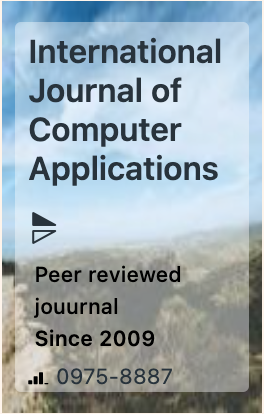The week's pick
Random Articles
Reseach Article
Cyberbullying Detection on Social Media Platforms Utilizing Different Machine Learning Approaches
| International Journal of Computer Applications |
| Foundation of Computer Science (FCS), NY, USA |
| Volume 186 - Number 61 |
| Year of Publication: 2025 |
| Authors: Farjana Akter, Md. Umor Faruk Jahangir, Md. Forhad Rabbi, Rajarshi Roy Chowdhury |
 10.5120/ijca2025924395
10.5120/ijca2025924395
|
Farjana Akter, Md. Umor Faruk Jahangir, Md. Forhad Rabbi, Rajarshi Roy Chowdhury . Cyberbullying Detection on Social Media Platforms Utilizing Different Machine Learning Approaches. International Journal of Computer Applications. 186, 61 ( Jan 2025), 40-50. DOI=10.5120/ijca2025924395
Abstract
Cyberbullying in social media significantly impacts mental well-being of individuals and poses noteworthy barriers to creating safe online environments, especially in non-English speaking communities. Addressing cyberbullying challenges requires collaborative efforts from communities, educators, and technology platforms developers or designers. The primary concern of this study is to detect cyberbullying in Bangla language, utilizing various machine learning (ML) approaches. A cyberbullying Bangla dataset encompasses a range of texts, including both cyberbullying and non-cyberbullying content. This dataset undergoes preprocessing stage, whilst utilizing diverse techniques, including tokenization, data augmentation, and transformation into sequences, for facilitating the creation of appropriate inputs for various ML approaches such as XGBoost (XGB), Gradient Boosting (GB), Decision Tree (DT), Random Forest (RF), Artificial Neural Network (ANN), Convolutional Neural Network (CNN) and Long Short-Term Memory (LSTM). Data is collected using web scraping from different social media platforms, which contains five distinct categories: neutral, threat, troll, political and sexual categories. Experimental results indicated that the proposed cyberbullying detection model achieves an exceptional accuracy of 99.80% with LSTM, surpassing other deep learning based algorithms. Conversely, XGB achieves a commendable accuracy of over 74% with the same dataset, outperforming other traditional ML algorithms. The findings contribute significantly to the development of proactive measures to prevent and mitigate cyberbullying, eventually advancing a safer online environment for individuals communicating in Bangla.
References
- M. Fire, R. Goldschmidt, and Y. Elovici, “Online social networks: Threats and solutions,” IEEE Communications Surveys and Tutorials, vol. 16, no. 4, pp. 2019–2036, Apr. 2014, doi: 10.1109/COMST.2014.2321628.
- A. K. Mishra and B. K. Ratha, “Study of Random Tree and Random Forest Data Mining Algorithms for Microarray Data Analysis,” International Journal on Advanced Electrical and Computer Engineering (IJAECE), vol. 3, no. 4, pp. 5–7, 2016, Accessed: Jun. 18, 2021. [Online]. Available: http://www.irdindia.in/journal_ijaece/pdf/vol3_iss4/2.pdf
- H. H. S. Li, Z. Yang, Q. Lv, R. I. R. R. Han, and S. Mishra, “A Comparison of Common Users across Instagram and Ask.fm to Better Understand Cyberbullying,” in 2014 IEEE Fourth International Conference on Big Data and Cloud Computing, IEEE, Dec. 2014, pp. 355–362. doi: 10.1109/BDCloud.2014.87.
- H. Lauw, J. C. Shafer, R. Agrawal, and A. Ntoulas, “Homophily in the digital world: A livejournal case study,” IEEE Internet Comput, vol. 14, no. 2, pp. 15–23, Mar. 2010, doi: 10.1109/MIC.2010.25.
- D. K. Citron, “Addressing cyber harassment: An overview of hate crimes in cyberspace,” 2015. [Online]. Available: http://www.usu.edu/today/index.cfm?id=54178.
- C. Van Hee et al., “Automatic detection of cyberbullying in social media text,” PLoS One, vol. 13, no. 10, Oct. 2018, doi: 10.1371/journal.pone.0203794.
- Unicef, “Cyberbullying: What is it and how to stop it | UNICEF.” Accessed: Aug. 29, 2024. [Online]. Available: https://www.unicef.org/end-violence/how-to-stop-cyberbullying
- B. A. Talpur and D. O’Sullivan, “Cyberbullying severity detection: A machine learning approach,” PLoS One, vol. 15, no. 10 October, Oct. 2020, doi: 10.1371/journal.pone.0240924.
- H. Sampasa-Kanyinga, P. Roumeliotis, and H. Xu, “Associations between cyberbullying and school bullying victimization and suicidal ideation, plans and attempts among Canadian schoolchildren,” PLoS One, vol. 9, no. 7, Jul. 2014, doi: 10.1371/journal.pone.0102145.
- T. Safaria, “Prevalence and Impact of Cyberbullying in a Sample of Indonesian Junior High School Students,” 2016.
- N. Safi Samghabadi, S. Maharjan, A. Sprague, R. Diaz-Sprague, and T. Solorio, “Detecting Nastiness in Social Media,” Association for Computational Linguistics, 2017. [Online]. Available: http://pythonhosted.org/pyenchant/
- M. Yao, C. Chelmis, and D. S. Zois, “Cyberbullying ends here: Towards robust detection of cyberbullying in social media,” in The Web Conference 2019 - Proceedings of the World Wide Web Conference, WWW 2019, Association for Computing Machinery, Inc, May 2019, pp. 3427–3433. doi: 10.1145/3308558.3313462.
- Q. Huang, V. K. Singh, and P. K. Atrey, “Cyber bullying detection using social and textual analysis,” in SAM 2014 - Proceedings of the 3rd International Workshop on Socially-Aware Multimedia, Workshop of MM 2014, Association for Computing Machinery, Nov. 2014, pp. 3–6. doi: 10.1145/2661126.2661133.
- T. Bin Abdur Rakib and L. K. Soon, “Using the Reddit Corpus for Cyberbully Detection,” Lecture Notes in Computer Science (including subseries Lecture Notes in Artificial Intelligence and Lecture Notes in Bioinformatics), vol. 10751 LNAI, pp. 180–189, 2018, doi: 10.1007/978-3-319-75417-8_17.
- A. K. Das, A. Al Asif, A. Paul, and M. N. Hossain, “Bangla hate speech detection on social media using attention-based recurrent neural network,” Journal of Intelligent Systems, vol. 30, no. 1, pp. 578–591, Jan. 2021, doi: 10.1515/jisys-2020-0060.
- S. B. Shanto, M. J. Islam, and M. A. Samad, “Cyberbullying Detection using Deep Learning Techniques on Bangla Facebook Comments,” Proceedings of 2023 International Conference on Intelligent Systems, Advanced Computing and Communication, ISACC 2023, 2023, doi: 10.1109/ISACC56298.2023.10083690.
- S. S. Nath, R. Karim, and M. H. Miraz, “Deep Learning Based Cyberbullying Detection in Bangla Language,” Annals of Emerging Technologies in Computing, vol. 8, no. 1, pp. 50–65, 2024, doi: 10.33166/AETiC.2024.01.005.
- L. Breiman, “Random forests,” Mach Learn, vol. 45, no. 1, pp. 5–32, Oct. 2001, doi: 10.1023/A:1010933404324.
- R. R. Chowdhury and P. E. Abas, “A survey on device fingerprinting approach for resource-constraint IoT devices: Comparative study and research challenges,” Nov. 01, 2022, Elsevier B.V. doi: 10.1016/j.iot.2022.100632.
- R. R. Chowdhury, A. C. Idris, and P. E. Abas, “Identifying SH-IoT devices from network traffic characteristics using random forest classifier,” Wireless Networks, 2023, doi: 10.1007/s11276-023-03478-3.
- R. R. Chowdhury, S. Aneja, N. Aneja, and E. Abas, “Network Traffic Analysis based IoT Device Identification,” in ACM International Conference Proceeding Series, Association for Computing Machinery, Aug. 2020, pp. 79–89. doi: 10.1145/3421537.3421545.
- M. Sheykhmousa, M. Mahdianpari, H. Ghanbari, F. Mohammadimanesh, P. Ghamisi, and S. Homayouni, “Support Vector Machine Versus Random Forest for Remote Sensing Image Classification: A Meta-Analysis and Systematic Review,” 2020, Institute of Electrical and Electronics Engineers Inc. doi: 10.1109/JSTARS.2020.3026724.
- C. Bentéjac, A. Csörgő, and G. Martínez-Muñoz, “A comparative analysis of gradient boosting algorithms,” Artif Intell Rev, vol. 54, no. 3, pp. 1937–1967, Mar. 2021, doi: 10.1007/s10462-020-09896-5.
- Z. Zhang, Y. Zhao, A. Canes, D. Steinberg, and O. Lyashevska, “Predictive analytics with gradient boosting in clinical medicine,” Ann Transl Med, vol. 7, no. 7, pp. 152–152, Apr. 2019, doi: 10.21037/atm.2019.03.29.
- S. Neelakandan and D. Paulraj, “A gradient boosted decision tree-based sentiment classification of twitter data,” Int J Wavelets Multiresolut Inf Process, vol. 18, no. 4, Jul. 2020, doi: 10.1142/S0219691320500277.
- S. Russell and P. Norvig, “Artificial Intelligence: A Modern Approach, 4th US ed.” Accessed: Aug. 29, 2024. [Online]. Available: https://aima.cs.berkeley.edu/
- Md. S. Azam, A. Rahman, S. M. H. S. Iqbal, and Md. T. Ahmed, “Prediction of Liver Diseases by Using Few Machine Learning Based Approaches,” Australian Journal of Engineering and Innovative Technology, pp. 85–90, Oct. 2020, doi: 10.34104/ajeit.020.085090.
- N. Singh and S. Sharma, “Review of Machine Learning methods for Identification of Cyberbullying in Social Media,” in International Conference on Artificial Intelligence and Smart, 2021. Accessed: Aug. 29, 2024. [Online]. Available: https://ieeexplore.ieee.org.
- A. Ali and A. M. Syed, “Cyberbullying Detection Using Machine Learning,” Pakistan Journal of Engineering and Technology, vol. 3, no. 2, 2020.
- H. Hosseinmardi, S. A. Mattson, R. I. Rafiq, R. Han, Q. Lv, and S. Mishra, “Detection of Cyberbullying Incidents on the Instagram Social Network,” Mar. 2015, [Online]. Available: http://arxiv.org/abs/1503.03909
- W. Chen, K. Fu, J. Zuo, X. Zheng, T. Huang, and W. Ren, “Radar emitter classification for large data set based on weighted-xgboost,” IET Radar, Sonar and Navigation, vol. 11, no. 8, pp. 1203–1207, Aug. 2017, doi: 10.1049/iet-rsn.2016.0632.
- A. Natekin and A. Knoll, “Gradient boosting machines, a tutorial,” Front Neurorobot, vol. 7, no. DEC, 2013, doi: 10.3389/fnbot.2013.00021.
- A. Gupta, S. Sharma, S. Goyal, and M. Rashid, “Novel XGBoost Tuned Machine Learning Model for Software Bug Prediction,” in 2020 International Conference on Intelligent Engineering and Management (ICIEM), IEEE, 2020.
- L. Torlay, M. Perrone-Bertolotti, E. Thomas, and M. Baciu, “Machine learning–XGBoost analysis of language networks to classify patients with epilepsy,” Brain Inform, vol. 4, no. 3, pp. 159–169, Sep. 2017, doi: 10.1007/s40708-017-0065-7.
- A. Ogunleye and Q. G. Wang, “XGBoost Model for Chronic Kidney Disease Diagnosis,” IEEE/ACM Trans Comput Biol Bioinform, vol. 17, no. 6, pp. 2131–2140, Nov. 2020, doi: 10.1109/TCBB.2019.2911071.
- J. Lever, M. Krzywinski, and N. Altman, “Points of Significance: Logistic regression,” Nat Methods, vol. 13, no. 7, pp. 541–542, Jun. 2016, doi: 10.1038/nmeth.3904.
- K. Regulski, A. Opaliński, J. Swadźba, P. Sitkowski, P. Wąsowicz, and A. Kwietniewska-Śmietana, “Machine Learning Prediction Techniques in the Optimization of Diagnostic Laboratories’ Network Operations,” Applied Sciences (Switzerland), vol. 14, no. 6, Mar. 2024, doi: 10.3390/app14062429.
- M. S. Al-Batah, M. Alzyoud, R. Alazaidah, M. Toubat, H. Alzoubi, and A. Olaiyat, “EARLY PREDICTION OF CERVICAL CANCER USING MACHINE LEARNING TECHNIQUES,” Jordanian Journal of Computers and Information Technology, vol. 8, no. 4, pp. 357–369, Dec. 2022, doi: 10.5455/jjcit.71-1661691447.
- S. Bhanu Prakash, V. Amudha, and N. Meenakshisundaram, “Efficient Human Action Recognition using Novel Logistic Regression Compared over Linear Regression with Improved Accuracy,” Proceedings of 8th IEEE International Conference on Science, Technology, Engineering and Mathematics, ICONSTEM 2023, 2023, doi: 10.1109/ICONSTEM56934.2023.10142567.
- J. E. Koskimaki et al., “Natural Language Processing-Optimized Case Selection for Real-World Evidence Studies,” 2022.
- R. Nisbet, J. Elder, and G. Miner, Handbook of Statistical Analysis and Data Mining Applications - Robert Nisbet, John Elder, Gary D. Miner - Google Books. 2009. Accessed: Aug. 31, 2024. [Online]. Available: https://books.google.com.bd.
- T. Bellini, “IFRS 9 and CECL Credit Risk Modelling and Validation-A Practical Guide with Examples in R and SAS,” 2019.
- M. A. Ferrag, L. Maglaras, A. Ahmim, M. Derdour, and H. Janicke, “RDTIDS: Rules and decision tree-based intrusion detection system for internet-of-things networks,” Future Internet, vol. 12, no. 3, Mar. 2020, doi: 10.3390/fi12030044.
- R. Jehad and S. A.Yousif, “Fake News Classification Using Random Forest and Decision Tree (J48),” Al-Nahrain Journal of Science, vol. 23, no. 4, pp. 49–55, Dec. 2020, doi: 10.22401/ANJS.23.4.09.
- Y. Freund and R. E. Schapire, “A Decision-Theoretic Generalization of On-Line Learning and an Application to Boosting,” J Comput Syst Sci, vol. 55, no. 1, pp. 119–139, 1997.
- H. Liu, X. Zhang, and X. Zhang, “PwAdaBoost: Possible world based AdaBoost algorithm for classifying uncertain data,” Knowl Based Syst, vol. 186, p. 104930, Dec. 2019, doi: 10.1016/J.KNOSYS.2019.104930.
- L. Li, C. Wang, W. Li, and J. Chen, “Hyperspectral image classification by AdaBoost weighted composite kernel extreme learning machines,” Neurocomputing, vol. 275, pp. 1725–1733, Jan. 2018, doi: 10.1016/J.NEUCOM.2017.09.004.
- Y. L. He, Y. Zhao, X. Hu, X. N. Yan, Q. X. Zhu, and Y. Xu, “Fault diagnosis using novel AdaBoost based discriminant locality preserving projection with resamples,” Eng Appl Artif Intell, vol. 91, p. 103631, May 2020, doi: 10.1016/J.ENGAPPAI.2020.103631.
- B. Zhao, X. Zhang, H. Li, and Z. Yang, “Intelligent fault diagnosis of rolling bearings based on normalized CNN considering data imbalance and variable working conditions,” Knowl Based Syst, vol. 199, p. 105971, Jul. 2020, doi: 10.1016/J.KNOSYS.2020.105971.
- O. Messai, F. Hachouf, and Z. A. Seghir, “AdaBoost neural network and cyclopean view for no-reference stereoscopic image quality assessment,” Signal Process Image Commun, vol. 82, p. 115772, Mar. 2020, doi: 10.1016/J.IMAGE.2019.115772.
- Z. Li, F. Liu, W. Yang, S. Peng, and J. Zhou, “A Survey of Convolutional Neural Networks: Analysis, Applications, and Prospects,” IEEE Trans Neural Netw Learn Syst, vol. 33, no. 12, pp. 6999–7019, Dec. 2022, doi: 10.1109/TNNLS.2021.3084827.
- R. Yamashita, M. Nishio, R. K. G. Do, and K. Togashi, “Convolutional neural networks: an overview and application in radiology,” Aug. 01, 2018, Springer Verlag. doi: 10.1007/s13244-018-0639-9.
- K. Simonyan and A. Zisserman, “Very Deep Convolutional Networks for Large-Scale Image Recognition,” Sep. 2014, doi: 10.48550/arXiv.1409.1556.
- R. Chauhan, K. K. Ghanshala, and R. C. Joshi, “Convolutional Neural Network (CNN) for Image Detection and Recognition,” in ICSCCC 2018 - 1st International Conference on Secure Cyber Computing and Communications, Institute of Electrical and Electronics Engineers Inc., Jul. 2018, pp. 278–282. doi: 10.1109/ICSCCC.2018.8703316.
- T. Chen, R. Xu, Y. He, and X. Wang, “Improving sentiment analysis via sentence type classification using BiLSTM-CRF and CNN,” Expert Syst Appl, vol. 72, pp. 221–230, Apr. 2017, doi: 10.1016/j.eswa.2016.10.065.
- K. Palanisamy, D. Singhania, and A. Yao, “Rethinking CNN Models for Audio Classification,” Jul. 2020, [Online]. Available: http://arxiv.org/abs/2007.11154
- Y. Fan, X. Lu, D. Li, and Y. Liu, “Video-Based emotion recognition using CNN-RNN and C3D hybrid networks,” ICMI 2016 - Proceedings of the 18th ACM International Conference on Multimodal Interaction, pp. 445–450, Oct. 2016, doi: 10.1145/2993148.2997632.
- K. M. Hasib, M. A. Habib, N. A. Towhid, and M. I. H. Showrov, “A Novel Deep Learning based Sentiment Analysis of Twitter Data for US Airline Service,” 2021 International Conference on Information and Communication Technology for Sustainable Development, ICICT4SD 2021 - Proceedings, pp. 450–455, Feb. 2021, doi: 10.1109/ICICT4SD50815.2021.9396879.
- K. Greff, R. K. Srivastava, J. Koutnik, B. R. Steunebrink, and J. Schmidhuber, “LSTM: A Search Space Odyssey,” IEEE Trans Neural Netw Learn Syst, vol. 28, no. 10, pp. 2222–2232, Oct. 2017, doi: 10.1109/TNNLS.2016.2582924.
- U. M. Devi, A. Marimuthu, and R. Scholar, “Donor-Recipient for Liver Transplantation Using CNN and LSTM Deep Learning Techniques,” 2021.
- I. Sutskever, O. Vinyals, and Q. V Le, “Sequence to sequence learning with neural networks,” Adv Neural Inf Process Syst, vol. 27, pp. 3104–3112, 2014.
- F. Altche and A. De La Fortelle, “An LSTM network for highway trajectory prediction,” IEEE Conference on Intelligent Transportation Systems, Proceedings, ITSC, vol. 2018-March, pp. 353–359, Jul. 2017, doi: 10.1109/ITSC.2017.8317913.
- H. Palangi et al., “Deep Sentence embedding using long short-term memory networks: Analysis and application to information retrieval,” IEEE/ACM Trans Audio Speech Lang Process, vol. 24, no. 4, pp. 694–707, Apr. 2016, doi: 10.1109/TASLP.2016.2520371.
- N. Mallinar and C. Rosset, “Deep Canonically Correlated LSTMs,” Jan. 2018, [Online]. Available: http://arxiv.org/abs/1801.05407
- V. S. Dave and K. Dutta, “Neural network based models for software effort estimation: A review,” Artif Intell Rev, vol. 42, no. 2, pp. 295–307, May 2014, doi: 10.1007/S10462-012-9339-X/METRICS.
- S. Haykin, Neural Networks and Learning Machines. 2009. Accessed: Aug. 31, 2024. [Online]. Available: https://books.google.com.bd
- S. Haykin, “Neural networks expand SP’s horizons,” IEEE Signal Process Mag, vol. 13, no. 2, pp. 24–49, 1996, doi: 10.1109/79.487040.
- A. Samnioti and V. Gaganis, “Applications of Machine Learning in Subsurface Reservoir Simulation—A Review—Part II,” Sep. 01, 2023, Multidisciplinary Digital Publishing Institute (MDPI). doi: 10.3390/en16186727.
- D. Wang, H. He, and D. Liu, “Intelligent Optimal Control with Critic Learning for a Nonlinear Overhead Crane System,” IEEE Trans Industr Inform, vol. 14, no. 7, pp. 2932–2940, Jul. 2018, doi: 10.1109/TII.2017.2771256.
- A. Mozaffari, M. Emami, and A. Fathi, “A comprehensive investigation into the performance, robustness, scalability and convergence of chaos-enhanced evolutionary algorithms with boundary constraints,” Artif Intell Rev, vol. 52, no. 4, pp. 2319–2380, Dec. 2019, doi: 10.1007/S10462-018-9616-4/FIGURES/6.
- H. He and E. A. Garcia, “Learning from imbalanced data,” IEEE Trans Knowl Data Eng, vol. 21, no. 9, pp. 1263–1284, Sep. 2009, doi: 10.1109/TKDE.2008.239.
- O. Isaac Abiodun, A. Jantan, A. Esther Omolara, K. Victoria Dada, N. AbdElatif Mohamed, and H. Arshad, “State-of-the-art in artificial neural network applications: A survey,” Heliyon, vol. 4, p. e00938, 2018, doi: 10.1016/j.heliyon.2018.
- S. Aneja, N. Aneja, B. Bhargava, and R. R. Chowdhury, “Device fingerprinting using deep convolutional neural networks’,” 2022.
- O. I. Abiodun et al., “Comprehensive Review of Artificial Neural Network Applications to Pattern Recognition,” IEEE Access, vol. 7, pp. 158820–158846, 2019, doi: 10.1109/ACCESS.2019.2945545.
- B. C. Kamble, “Speech Recognition Using Artificial Neural Network – A Review,” International Journal of Computing, Communication and Instrumentation Engineering, vol. 3, no. 1, Jan. 2016, doi: 10.15242/ijccie.u0116002.
- D. W. Otter, J. R. Medina, and J. K. Kalita, “A Survey of the Usages of Deep Learning for Natural Language Processing,” IEEE Trans Neural Netw Learn Syst, vol. 32, no. 2, pp. 604–624, Feb. 2021, doi: 10.1109/TNNLS.2020.2979670.
- N. E. Benti, M. D. Chaka, and A. G. Semie, “Forecasting Renewable Energy Generation with Machine Learning and Deep Learning: Current Advances and Future Prospects,” May 01, 2023, MDPI. doi: 10.3390/su15097087.
- M. A. Khder, “Web scraping or web crawling: State of art, techniques, approaches and application,” International Journal of Advances in Soft Computing and its Applications, vol. 13, no. 3, pp. 144–168, 2021, doi: 10.15849/ijasca.211128.11.
- R. R. Chowdhury, A. Che Idris, and P. E. Abas, “Packet-level and IEEE 802.11 MAC frame-level analysis for IoT device identification,” Turkish Journal of Electrical Engineering and Computer Sciences, vol. 30, pp. 1–1, 2022, doi: 10.3906/elk-1300-0632.3915.
- R. R. Chowdhury, A. C. Idris, and P. E. Abas, “Internet of things: Digital footprints carry a device identity,” in AIP Conference Proceedings 2643, 2023, p. 40003. doi: 10.1063/5.0111335.
- R. R. Chowdhury, A. C. Idris, and P. E. Abas, “Internet of Things Device Classification using Transport and Network Layers Communication Traffic Traces,” International Journal of Computing and Digital Systems, vol. 12, no. 1, pp. 545–555, 2022, doi: 10.12785/ijcds/120144.
- M. Miettinen, S. Marchal, and N. Asokan, “IoT Sentinel: Automated Device-Type Identification for Security Enforcement in IoT,” 2017 IEEE 37th International Conference on Distributed Computing Systems (ICDCS), pp. 2177–2184, 2017, doi: 10.1109/ICDCS.2017.284.
Index Terms
Keywords

